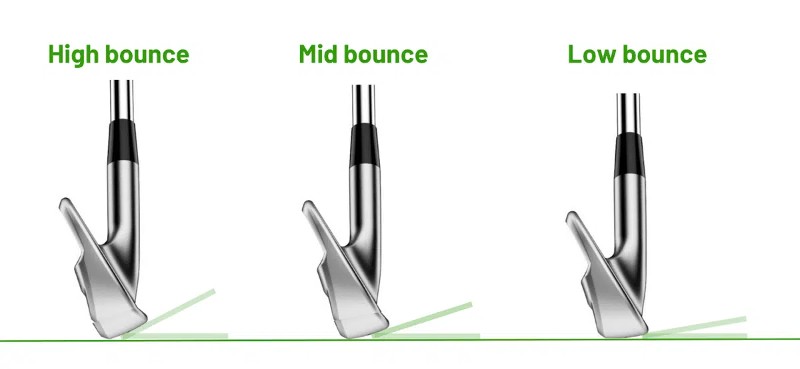|
Getting your Trinity Audio player ready...
|
Wedge bounce is a crucial consideration for any golfer seeking to enhance their game. Understanding this concept can be perplexing, so our goal in this piece is to demystify the terminology. So, what exactly is wedge bounce?
Golf wedge bounce refers to the angle from the sole’s trailing edge to the leading edge of the club head. Depending on the depth of your divots, the club’s edge will either skim over the turf or dig into it before making contact with the ball.
Neglecting wedge bounce can significantly harm your short game.
Choosing the appropriate bounce prevents your club from digging into the ground consistently and mishitting chip shots. You might be using a wedge with a bounce level ill-suited to your skill level or the courses you play on.
It’s a straightforward adjustment, but first, we need to grasp some fundamentals.
Understanding the Basics of Wedge Bounce
As a rule of thumb: the more thought you put into selecting your wedges, the better they’ll perform on the course.
To accomplish this, let’s embark on a brief journey.
First, we must comprehend how wedge bounce influences our shots. Then we’ll explore the available wedges on the market. After that, we’ll examine the various bounce options. Lastly, we’ll delve into the types of grinds.
Ready?
Let’s begin.
How Wedge Bounce Affects Your Shots?
Wedge bounce, measured in degrees, dictates how your club interacts with different surfaces. Opting for a higher bounce helps avoid fat shots, as insufficient bounce can lead to the club digging into the ground and sending the ball high off the face upon contact.
For instance, when playing from softer turf, it’s advisable to use a wedge with a higher degree of bounce, as it creates more resistance between the club and the surface.
Conversely, when playing from firmer terrains, consider a wedge with lower bounce.
Failing to select an appropriate bounce level can result in striking issues such as thin shots or excessively long shots due to excessive grounding upon impact. This will become clearer as we examine the various bounce types.
Types of Wedges
There are four types of wedges. For beginners, a gap wedge might be optional. However, having four wedges in your arsenal can be advantageous for intermediate golfers or those with a strong short game.
- When you’re about 120 yards out, use your Pitching Wedge (PW).
- At just over a hundred yards away, approach the green with your Gap Wedge (GW), which fills the distance gap between the PW and SW. The margin for error is smaller when approaching the green. You can learn more about the differences between a gap wedge and an approach wedge in our article.
- In bunkering situations or when closer to the flagstick than 100 yards away, utilize your Sand Wedge (SW).
- For high trajectory shots like chipping over sand traps or flop shots, opt for the Lob Wedge (LW).
Types of Bounce
So, what does bounce mean regarding wedges?
There are three types of bounce: high, mid, and low.
The simplest way to start is to envision the club striking the ground just ahead of the ball. The wedge bounce chart below illustrates how different leading edge angles can affect ball trajectory.
Low bounce: Wedges with 4 – 6° of bounce are suitable for hard surfaces, as they skip off the ground easily. If your golfing style emphasizes clean contact and shallow angle shots without producing large divots, this type of wedge is ideal. These wedges are designed to maximize friction between the club head and the turf.
Mid bounce: Wedges with 7-12° of bounce. This offers the most versatile playability regardless of conditions or swing types.
High bounce: For golfers who typically take deep divots or play on soft soil, high bounce wedges with over 12° of bounce prevent excessive digging into the turf.
Types of Grinds
A wedge’s grind refers to the amount of material removed from the club’s sole.
Depending on your shot preference, the grind type on a wedge influences its turf interaction.
Before delving into wedge grinds, ask yourself a couple of simple questions.
Firstly, consider the conditions. What kind of terrain and turf do you typically play on? Are the grounds tight and firm or more rugged?
Secondly, think about your club’s impact on the turf. If you take large divots with every swing, you likely need a wider sole. This isn’t necessary if you strike the ball cleanly without leaving marks behind.
Answering these questions will help determine the right choice for you.
If you play on thicker grass and take a reasonable divot, a standard grind with minimal material removed from the heel and toe is likely best. If you play on flatter fairways, perhaps a more aggressive grind that allows the club to sit flatly on a tight lie would work better.
So which grind should you choose?
Here’s where things can get a bit confusing with grinds. Each manufacturer uses their own labels or letters to represent different grinds. If you’re committed to a particular brand, it’s worth exploring their options.
That said, Bob Vokey is widely regarded as the master of wedges. Vokey wedges (Titleist) can be categorized as follows:
| Vokey Wedge Grind | Description |
| T Grind | The T-Grind is an ideal wedge for golfers of any skill level. Its low bounce makes it versatile in any condition – firm courses, bunkers with shallow sand, or even links conditions. |
| F Grind | The F-Grind wedge features a full sole with no grinding. It has camber and radius angles that help take advantage of all types of distances. The F-Grind remains popular among PGA Tour and LPGA Tour players due to its versatility. |
| S Grind | The S grind wedges provide a balanced bounce and make the perfect choice when playing neutral shots near the green. |
| M Grind | Perfect for medium-firm conditions yet can easily handle softer surfaces, too, making it ideal for sliders who need extra spin control. |
| K Grind | The most forgiving bounce option, making it ideal for mid-high handicappers. |
| L Grind | With the lowest bounce available, the L grind allows players to easily open up the face of their clubs and hit a wide variety of shots from any firm surface. |
| D Grind | The newest addition to the Vokey family, the D grind is an optimal option for golfers playing on soft courses due to its high bounce angle. |
Types of Lofts
Most golfers typically carry between two to four wedges in their bag, depending on their skill level. Generally, most golfers carry sand, pitching, and lob wedges. Some may also carry a gap wedge to minimize distance gaps between wedges.
Each wedge typically has a loft range. The higher the loft– the more spin and control, but less distance.
These typical ranges are summarized in the table below.
| Club | Short Name | Loft (º) |
| Pitching Wedge | PW | 44 – 48 |
| Gap/Approach Wedge | GW/AW | 50 – 52 |
| Sand Wedge | SW | 54 – 58 |
| Lob Wedge | LW | 58 – 64 |
There is a plethora of wedges on the market offering various benefits. For instance, we believe the Cleveland CBX2 is currently the top wedge for women.
How to Choose the Right Wedge Bounce for Your Swing
The first consideration when selecting wedge bounce is the type of course you play most frequently. This is usually dictated by your local climate. Whether your fairways are soft or hard should be the primary factor in your decision. Ultimately, you want your wedge to interact well with the turf.
The general rule is:
- Firmer conditions require less bounce.
- Softer conditions demand more bounce.
Low bounce wedges will glide off hard ground, while high bounce wedges prevent excessive digging into soft turf.
The second consideration is your attack angle. If you have a steep attack angle and hinge your wrists a lot, you’ll need a higher bounce to prevent digging into the ground. Conversely, a lower bounce is suitable if you have a shallower swing with minimal wrist movement.
For instance, if you tend to take divots and play on soft turf, a low bounce club will likely dig too deeply.
Ultimately, we aim to make crisp ball contact without disturbing the natural habitat of indigenous creatures like moles and worms.
For example, a high bounce sand wedge might be better suited in this scenario.
Tips to Maximize the Benefits of Wedge Bounce
Leveraging wedge bounce begins with understanding the different types available, as outlined above. A wedge with bounce tailored to your swing and regular playing conditions enables you to maximize spin and control with your approach shots. Here are three practical steps to further refine your wedge play.
Understand the different grinds – Knowing the distinctions between different grinds can help fine-tune your accuracy. Once you’ve identified whether you need low, medium, or high bounce, you can further optimize by selecting the appropriate grind.
Experiment with different bounce options – As your game evolves, it’s essential to experiment with different bounce options to see if they continue to suit your needs as you improve. This also helps you become comfortable executing various types of approach shots around the green.
Common Misconceptions about Wedge Bounce
The overarching lesson (as is often the case in golf) is that general advice doesn’t always apply to all golfers. Typically, those with steep attack angles require more bounce on their wedges. However, golfers may naturally adjust their swing under different conditions, which can counteract the benefits of bounce.
Some advice found online may suggest a ‘superior’ bounce and grind combination that unequivocally improves your game. Unfortunately, as much as a straightforward solution to finding the right bounce is desirable, things are often more nuanced.
Every golf swing is unique. To understand the bounce and grind that best suits your game, you’ll need a professional club fitting. Hitting a hundred shots in a simulator that tracks your angle of attack, smash factor, and contact point will provide a definitive answer.
By asking questions like “what is wedge bounce?” you’re already giving yourself an advantage over your peers. Understanding these concepts allows you to incorporate them into your decision-making on the course.
A Simple Drill to Improve Your Wedge Bounce
If you tend to top the ball or take too much turf, this straightforward drill can be immensely helpful.
- Begin by removing the ball.
- Repeatedly try to skim the surface until you effortlessly brush the turf.
- Once the ball is reintroduced, the cleaner contact point will optimize the benefits of the bounce and grind you’re using.
FAQ
What Bounce Is Best for Wedges?
For most golfers in most conditions, mid-bounce wedges with an angle of 7 to 12 degrees are optimal.
Is 12 Degrees of Bounce Too Much?
Clubs with more than 12 degrees of bounce are considered high bounce and are suitable for golfers who play in soft conditions and typically take divots. Some golfers may find 12 degrees too much for firm conditions.
What Is a Normal Bounce for a Wedge?
Mid-bounce wedges, also known as “medium” or “standard bounce,” typically offer a range of 7-12 degrees of bounce and can be used on firm or regular turf conditions.
What Bounce Are Tiger Woods Wedges?
Tiger uses TaylorMade Milled Grind 3 (MG3) wedges in 56 and 60 degrees loft. The 56-degree wedge has 12 degrees of bounce, while the 60-degree wedge has 11 degrees of bounce.
Final Thoughts
Major wedge manufacturers like Titleist, PING, and Callaway offer various wedge bounce options.
Being mindful of turf conditions and your swing tendencies will benefit you more than the average golfer. If you’re seeking areas to lower your handicap, a professional fitting to determine the optimal wedge bounce for your game could be advantageous!






